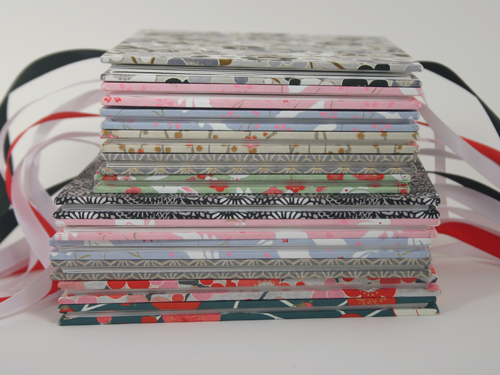Paper Folding Meditation and the Business of Bookbinding
May 4th, 2009 | Link
I spent most of the weekend folding paper. It was the first weekend in weeks that I didn’t work, and it was raining, so I stayed in and watched animé with E. while he experimented with Python and I folded and tore paper. It was nice to be doing something that didn’t require focus after the deadlines of last week.
I grabbed all of the remaining 119 gsm Mohawk Superfine sheets off my paper cart and started folding. I thought there were only about 20 sheets (25″ by 35″, grain short), but when I finally finished I realized there had been quite a few more. All told, I folded and tore 46 full-size sheets into 736 4-1/4″ by 5-1/2″ folios. That’s folding sheets of paper in varying sizes in half 1426 times, and ripping through the crease with a bone folder 690 times. No wonder my back hurts!
When you realize the amount of time it takes to do some of these things, it can be really disheartening to price your work for sale. I spent at least 7 hours folding and tearing paper by hand, and over an hour last night assembling the folios into sections. This is light-weight paper; I use six folios per section rather than the usual four, so with eight sections per book I prepared enough paper for about 15 books. That means it took about an hour just to prep the paper for two books. Depending on how I bind them, it will take another hour or more per book to prepare the covers and sew the bindings. If I sell these $18, after deducting the cost of materials I’m making about California minimum wage—and that’s before I even consider the amount of time it takes to photograph each piece, write a description, step through the five page form required to upload each book to Etsy, and deduct the additional fees for each sale to pay to Etsy and Paypal.
There are certain things that I can do to produce more, faster. I could use my Kutrimmer, rather than tear the paper. I could use heavier, larger sheets of paper (which I usually do—this paper is the last of an unfortunate online ordering choice), use four folios per section instead of six, or use fewer sections in the book. I could have made 8-1/2″ by 11″ folios and saved myself a few hundred folds and tears. I could choose to make only specific book structures, those which are faster to produce. I could even outsource, as my husband often teases. But when I start making creative decisions based on production optimization, it takes some of the fun and spontaneity out of the experience.
My Etsy store has been mostly empty these last few months, partly due to lack of time to produce anything to put into it, and partly due to lack of interest. When I produce for the sake of selling, I tend to go into production line mode, and I get bored with making the same structures over and over again. This year I want to explore more and make things for the sake of my own interests, and if they turn out well and I start running out of room again they’ll go up for sale.












